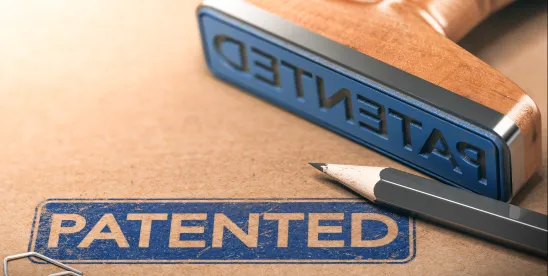The basis for obviousness-type double patenting (ODP) is found in 35 U.S.C. § 101, establishing an applicant is entitled to a single patent, “a patent” or the “first” patent, for an invention. Thus, any “second” patent to a patently indistinct invention implicates the policy concerns underpinning ODP. For pre-URAA[i] patents, the “first” patent was determined by issue date since that tolled the start of the 17-year patent term and was a stand-in for expiration date. For post-URAA patents, however, the Federal Circuit held in Gilead v. Natco[ii] that “it is the comparison of … expiration dates that should control, not merely the issuance dates” (emphasis added)[iii]. The Federal Circuit’s recent decision in Allergan v. MSN[iv] finally answered the question that has vexed practitioners since the Gilead holding: does the Gilead focus on expiration date apply to patent families sharing the same priority date? The answer is no. In Allergan, the court reverted to the pre-URAA focus on issue-date to identify the “first” patent in a patent family sharing the same priority date, holding that this “first” patent cannot be invalidated under ODP over a child continuation. Together, the Gilead and Allergan decisions establish a new rubric for determining the reference patent in an ODP analysis. Moreover, Allergan and the new rubric confirms the value of obtaining Patent Term Adjustment (PTA) in a first-issued patent in a patent family, and the inapplicability of ODP to the first-issued patent over a later-issued, earlier-expiring continuation patent.
The focus of Gilead on expiration dates was understandable given that it involved two unrelated patents where the 20-year patent term is tolled by the filing date, a stand-in for expiration date, and reliance on issue date could lead to “significant gamesmanship during prosecution”.[v] But the Gilead holding that a later-issued, earlier-expiring (“first”) patent can qualify as an ODP reference for an earlier-issued, later-expiring (“second”) patent created years of uncertainty about the validity of a first-issued patent in a family receiving an award of PTA. Such an award of PTA frequently made the first-issued patent earlier-issued and yet later-expiring compared to the related continuation patents, thus creating ODP risk to the first patent by a reflexive application of the Gilead focus on expiration date in view of the later-issued, earlier-expiring continuation. This risk was realized in several district court decisions[vi] leading to the fear that a parent patent receiving a PTA award could be invalidated by the later-issued, earlier-expiring continuation patent. This reflexive application of the Gilead holding to distinct facts led many commentators and practitioners to consider not filing continuation applications in view of the potential risk to a parent patent receiving a PTA award. The decision in Allergan resolved this uncertainty by holding that “a first-filed, first-issued, later-expiring [(“first”)] claim cannot be invalidated by a later-filed, later-issued, earlier-expiring [(“second”)] reference claim having a common priority date”. In doing so, the Allergan court clarified that the Gilead holding does not apply to patents having a shared priority date and affirmed the value of a PTA award in a first-issued patent, as well as the value of pursuing continuation applications.[vii]
The 20-year patent term for a patent family is tolled by the first non-provisional filing date in the family (the “priority date”), so the filing date and statutory expiration date do not distinguish the “first” and “second” patents in a patent family. What matters instead is the issue date as the first-issued patent in the family is the “first” patent under § 101 and any later-issuing continuation patent in the family is the “second” patent, whether or not the patent term for the later-issuing patent is extended. “As the first-filed, first-issued patent in its family, it is the patent that sets the maximum period of exclusivity for the claimed subject matter and any patentably indistinct variants.”[viii] Accordingly, the first-issued patent is the reference patent when the priority dates are shared. The application of ODP to continuation applications was addressed in our recent comments (“A Continuation Application is an Implicit Admission of Obviousness-Type Double Patenting When Filed from a Parent Patent”, 2024).
In contrast to Allergan, the patents at issue in Gilead were unrelated and had different priority dates, so the 20-year patent term for the patently indistinct inventions claimed in the Gilead patents was tolled by the first-filed patent, the “first” patent under § 101, irrespective of the issue dates. “Because the later-filed, earlier-issued asserted patent [of Gilead] did not claim priority from the earlier-filed, later-issued patent, it did not share an expiration date with that patent, and instead expired twenty years from its own, later filing date.”[ix] Thus, the filing date is a stand-in for the expiration date that was the focus in Gilead, such that when the priority dates are different, the first-filed patent is the reference patent. Accordingly, the following rubric serves as a guide for determining the reference patent in an ODP analysis:
- When the priority dates are different, the first-filed patent is the reference patent.
- When the priority dates are shared, the first-issued patent is the reference patent.
This new rubric is consistent with other Federal Circuit decisions regarding ODP. For example, similar to the decision in Allergan for patents having a shared priority date, Novartis v. Breckenridge[x] found a first-issued, later-expiring pre-URAA patent, the “first” patent, to be not invalid for ODP over the later-issued, earlier-expiring URAA continuation patent, the “second” patent. “‘The traditional concern with obviousness-type double patenting’ is not raised where ‘it is the earlier-filed, earlier issued … patent, not the later-filed, later-issued … patent, that has the later expiration date’.”[xi] The Breckenridge court found that the gamesmanship at issue in Gilead was not present when the priority date is shared: “Moreover, unlike Gilead, Novartis here did not structure the priority claim of its [“second”] patent to capture additional patent term beyond the term it was granted for its [“first”] patent.”[xii] While the pre-URAA nature of the first patent distinguishes Breckenridge from Allergan, the motivation for finding the patent not invalid is the same, as recognized by the Allergan court: “[T]he fact that the [first] patent expires later is of no consequence here because it is not a ‘second, later expiring patent for the same invention.’”[xiii] In contrast to Allergan and Breckenridge, the court in In re Cellect[xiv] found that a later-filed, later-issued, later-expiring URAA continuation patent, the “second” patent, invalid for ODP over the URAA parent patent, the “first” patent. “A crucial purpose of ODP is to prevent an inventor from securing a second, later-expiring patent for non-distinct claims.”[xv]
Other Federal Circuit decisions invalidating “second” patents with different priority dates include AbbVie v. Kennedy[xvi] and Sun v. Eli Lilly. [xvii] AbbVie involved the gamesmanship that was the concern of the Gilead court, where the “second” continuation patent was later-expiring because, while claiming priority to the filing date of the “first” patent, the “first” patent claimed priority to an earlier application that the “second” patent did not claim priority to. In finding the “second” patent invalid for ODP over the “first” patent, the AbbVie court found that gamesmanship exists when “the applicant chooses to file separate applications for overlapping subject matter and to claim different priority dates for the applications.”[xviii]
Similarly, Sun found the “second” later-filed patent invalid for ODP over the unrelated earlier-filed “first” patent claiming patently indistinct subject matter. The “first” patent in Sun claimed a compound the use of which was claimed in the “second” patent where the “first” patent described in the specification the use claimed in the “second” patent. In contrast, the earlier-filed, later-expiring “first” patent was found not invalid in Novartis v. Ezra over the unrelated later-filed, earlier-expiring “second” patent where the “first” patent was later-expiring due to an award of Patent Term Extension.[xix] In finding the first patent not invalid for ODP, the Ezra court distinguished Abbvie concluding that there is “no concern that Novartis, once its [first] patent issued, sought to subsequently ‘secur[e] a second, later expiring patent for the same invention’ as in Abbvie.”[xx]
Organizing Federal Circuit decisions by same versus different priority dates, and by first versus second patent challenged, shows the new rubric is consistent across the Federal Circuit decisions:
| Challenged Patent /
Patent Relationship |
“First” Not Invalid for ODP |
“Second” Invalid for ODP |
||
| Different Priority Dates | First-filed (first-issued) Ezra |
Second-filed (First-issued) Gilead |
Second-filed (second-issued) AbbVie Sun |
|
| Shared Priority Dates | First-issued (first-filed) Allergan Breckenridge |
First-issued (second-filed) |
Second-issued (second-filed) In re Cellect |
|
In view of this new rubric, and the Allergan holding, Applicants can confidently rely on the additional patent term afforded by a PTA award in a first-issued patent in a patent family. Continuation applications can also be pursued without concern of their impact on that PTA award in the first-issued patent. The patent term of the continuation patent cannot extend beyond the patent term of the first-issued patent, but that does not minimize the value of pursuing one or more continuation applications to meet the needs of the Applicant and product.
Endnotes:
[i] Uruguay Round Agreements Act (URAA) modified patent term from 17 to 20 years starting from the earliest non-provisional filing date for applications filed on or after June 8, 1995.
[ii]Gilead Scis., Inc. v. Natco Pharma Ltd., 753 F.3d 1208 (Fed. Cir. 2014).
[iii]Gilead, at 1215.
[iv]Allergan USA, Inc. v. MSN Labs. Priv. Ltd., 111 F.4th 1358, 1369 (Fed. Cir. 2024).
[v]Gilead, at 1215.
[vi] (a) Magna Elecs., Inc. v. TRW Auto. Holdings Corp., 2015 U.S. Dist. LEXIS 182044 (W.D. Mich. 2015), finding a first-filed, first-issued, parent patent that is later-expiring due to an award of PTA is invalid over the continuation patent; (b) Janssen Biotech, Inc. v. Celltrion Healthcare Co., 210 F.Supp.3d 278 (D.MA. 2016), finding a first-filed, first-issued, later-expiring pre-URAA parent patent is invalid for ODP over a post-URAA continuation patent.
[vii] “Unlike here, the challenged claims of the asserted patent in Gilead were filed after, claimed a later priority date than, and expired after the reference claims, which resulted in an unwarranted extension of patent term for an invention that had already been the subject of an earlier-filed, earlier-expiring claim. In contrast, claim 40 of the ‘356 patent was filed before, shares a priority date with, and issued before the reference claims of the ‘011 and ‘709 patents. Because the ‘356 patent was the first patent in its family to be filed and to issue, it does not extend any period of exclusivity on the claimed subject matter.” Allergan, at 1370.
[viii]Allergan, at 1369.
[ix]Allergan, at 1370.
[x]Novartis Pharms. Corp. v. Breckenridge Pharm. Inc., 909 F.3d 1355, 1366 (Fed. Cir. 2018).
[xi]Allergan, at 1370, citing Novartis AG v. Ezra Ventures LLC, 909 F.3d 1367, 1374 (Fed. Cir. 2018).
[xii]Breckenridge, at 1364.
[xiii]Allergan, at 1369, citing AbbVie Inc. v. Mathilda & Terence Kennedy Inst. of Rheumatology Trust, 764 F.3d 1366, 1373 (Fed. Cir. 2015).
[xiv]In re Cellect, LLC, 81 F.4th 1216 (Fed. Cir. 2023).
[xv]In re Cellect, at 1226.
[xvi]AbbVie, at 1381.
[xvii]Sun Pharm. Indus. v. Eli Lilly & Co., 611 F.3d 1381 (Fed. Cir. 2010).
[xviii]AbbVie, at 1373.
[xix]Ezra, at 1373.
[xx]Ezra, at 1375, citing Abbvie, at 1373.




 />i
/>i

